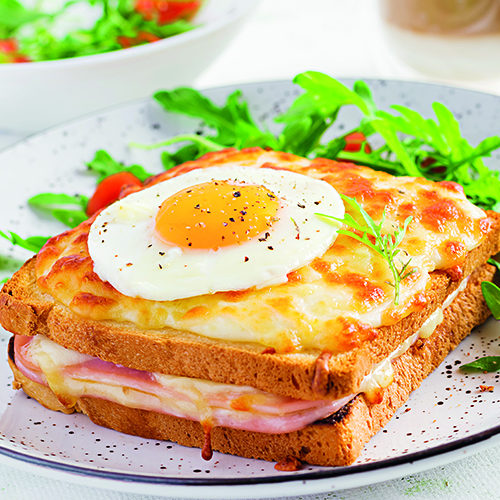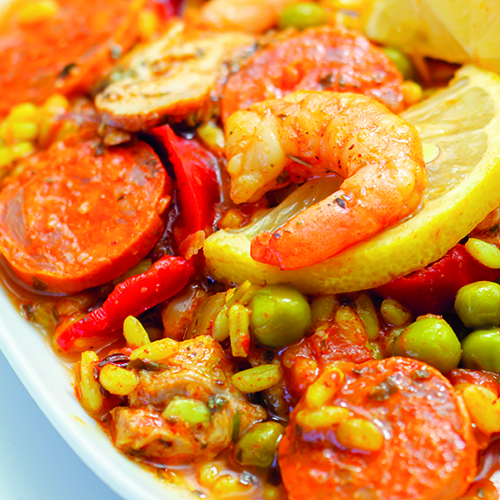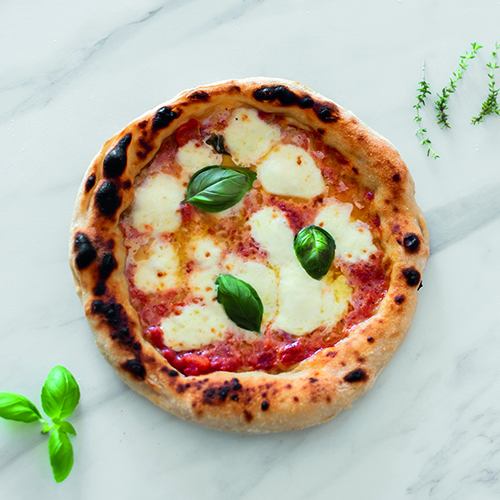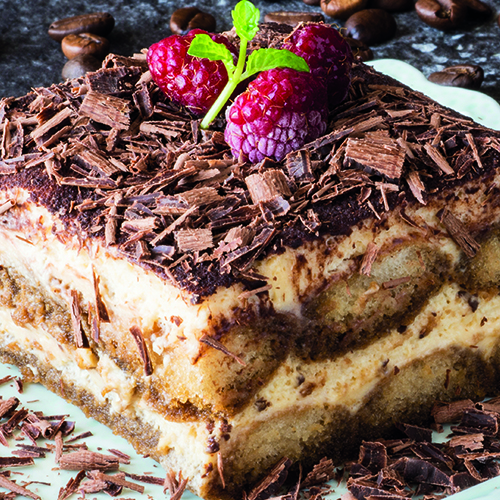
Find recipes for delicious, classic Mediterranean dishes that you can find on Royal Caribbean's Mediterranean itineraries in summer 2022.
Get inspiration for your next cruise holiday and enter our fantastic competition where you can WIN a Mediterranean cruise on on-board Anthem of the Seas AND to explore the Med one dish at a time from the comfort of your own home!
Dine your way around the Med and impress your dinner guests making your own classic Greek moussaka, flavoursome Spanish paella and indulge your sweet tooth with biscotti to have with a morning or afternoon coffee, and creamy tiramisu for dessert.
Get out your ingredients and start cooking up these Mediterranean delights.
Get Cooking





Italian Biscotti has become a beloved coffee shop staple around the world.
On your Brilliance of the Seas cruise to Croatia and Greece, you start and end your trip from the dazzling northern Italian city of Venice (Ravenna or Trieste).
While you spend time strolling Venice's myriad of tiny winding alleyways, stop at any of the inviting pasticceria for a pick me up of a cappuccino perfectly complemented with a freshly baked biscotti.
But where did this world-famous biscuit come from?
This northern Italian sweet treat was created in the town of Prato in Tuscany back in the fourteenth-century. It is a long, oblong-shaped, dry, hard, almond flavoured biscuit that gets its distinctive crunchy consistency by being baked twice. The traditional type is called biscotti di Prato (biscuits from Prato), or cantucci (meaning nook).
The technique of baking sweets and bread twice was invented so they were dry and would not go off and could be stored for a long time - which was extremely useful for long journeys or during wars. So, while modern biscotti is usually associated with chic coffee shops, it was created for practical reasons, to feed people who were far from home for a long time, and not get mouldy!
Its name is derived from the Latin biscotus, which means 'twice cooked', but in modern Italian, it has come to simply mean 'biscuit.'
As Italians travelled throughout Europe and beyond, other countries learned of the joys of biscotti and created their own versions, including French croquets de Carcassonne, made with butter with a softer texture; Jewish mandelbrot (mandel bread) made with canola oil with a mild taste and Moroccan fekkas, with added raisins for a moister taste.
Biscotti are now available in almost endless flavour variations, including pistachio, hazelnut, cashew, cherry, cappuccino, chocolate - even savoury flavours such as cheese.
Whichever flavour you go for, they are great to eat on their own - and even better when dipped in a coffee or hot chocolate.
After a day of exploring beautiful Mediterranean ports, savour the delights of more Mediterranean classics back onboard at Brilliance of the Sea's restaurants in the Main Dining Room, and more Med favourites plus delicious biscotti (where this recipe comes from) at Giovanni's Table.
To celebrate this tasty Italian sweet, we are sharing Giovanni's Kitchen and Wine Bar's recipe for biscotti with you, so you can recreate it at home to bring back delicious memories of your cruise.
Buon apetito!

Croque madame is a slightly lesser-known - but arguably improved - version of France's famous fancy grilled ham and cheese sandwich, the croque monsieur.
On your Vision of the Seas cruise to France, the French island of Corsica and Spain, you will stop at southern France's delightful maritime town of Sète; explore the peaceful island of Corsica enjoying the food and friendly welcome of Ajaccio; and impressive architecture, old churches, and lively café-filled squares in Palma de Mallorca, Cartagena and Valencia in Spain.
When you are out wandering the canal-filled, maritime town of Sète, or learning about the life of Napoleon Bonaparte and enjoying the city's museums, you may wish to try this French lunch or brunch classic at a local café.
But where did this world-famous dish come from?
The original croque monsieur was first seen on French menus in 1910. While the true beginning of it is unknown, a popular origin story is that it was created in a brasserie when the owner ran out of baguettes during a busy lunch rush, so put some ham and cheese in regular country bread and baked it to keep his customers fed.
It is made up of two slices of chunky pan de campagne (French country style bread), with thin layers of ham inside and cheese on top, fried in a pan. The cheese is traditionally beloved French cheese Gruyere, but Dutch Emmental, which has a similar consistency and flavour profile has become a staple with it as well.
A croque madame is the same thing, but with the addition of putting a fried egg on top.
The egg is cooked keeping the yolk a little runny, so it drips over the sandwich, adding to its flavour.
The word croque comes from the French verb, croquer, meaning to bite, munch, or crunch - what we do when we eat the sandwich. Madame means woman. So, its translation is taken as "bite (a) woman" or our favourite, "Miss crunch." (For croque monsieur, it means "bite [a] man" or "Mister crunch".)
The croque madame was first seen on menus in 1960, and was an innovation created to make it a heartier meal.
The reason it is called a croque madame - is because the fried or poached egg on the top is said to look like a lady's hat.
While strolling around the gorgeous French ports on your cruise, check out the local menus for croque madame, and see if they have any variations on the classic.
After a day of your own French sojourn, savour the delights of more Mediterranean classic dishes back onboard at Vision of the Sea's restaurants Giovanni's Table and the Main Dining Room.
To celebrate this comforting French favourite, we have created a recipe for croque madame honouring the traditional recipe, while offering your own personal twist, that you can recreate at home to bring back memories of your cruise.
Bon Appetit!

Moussaka is Greece's most famous and beloved dish, that every Greek family has their own way of cooking.
On your Odyssey of the Seas cruise to the Greek Isles, you will stop at Greece's ancient capital Athens, see the windmills and whitewashed houses in Mykonos, experience where history and religion meet at Ephesus, enjoy the small-town seaside charm of Souda on the island of Crete, and enjoy the magical views of the volcanic crater island of Santorini.
When you are out exploring the white-washed winding streets of tiny towns, and gazing at history and stunning views before you, you may wish to try this Greek classic for yourself at a local taverna.
But where did this world-famous dish come from?
An ancestor of moussaka is commonly thought to have been brought to Greece by visiting Arabs more than five hundred years ago, when they introduced the aubergine to the country. They introduced it to Turkey and Egypt too, so all four countries have a hand in its inception and proliferation.
However, in 1920, a French-educated Greek chef added béchamel sauce to further Europeanise the dish, creating the prototype of the modern version eaten today.
It is a staple dish not only in Greece, but also in Turkey, the Middle East, and the Balkans. The word moussaka is derived from the Arabic word musaqqâ, meaning "moistened."
The modern moussaka that we have come to know and love, has four elements as standard: gratin aubergine and potatoes, minced meat with béchamel on top. There are variations within Greece on whether to add courgette or tomato, and whether to fry or roast the aubergine. Our version includes courgette and roasting the aubergine - which is healthier than frying it and saves time too!
While strolling around the gorgeous Greek islands on your cruise, check out the local menus for moussaka, and ask how they cook it.
After a day of your own Greek odyssey, savour the delights of more Mediterranean classic dishes back onboard at Odyssey of the Sea's restaurants, Jamie's Italian, or Coastal Kitchen.
Kalí órexi!

Paella is without a doubt, Spain's most iconic dish.
On your Anthem of the Seas cruise to Spain and France, you will stop in culture-filled Bilbao, plus historic and seafood-filled La Coruna.
When you are out exploring the cobbled-stone streets, enjoying the historic buildings and museums of the cities, let your nose guide you to stop for a bite of paella for lunch or try a tapas portion to have a sample.
But where did this world-famous dish come from?
Well, its story began in the countryside of Valencia around two hundred years ago. Farm workers cooked the simple dish in a pan over a fire using rice and whatever they could find, which included: vegetables, snails, rabbit and later, also chicken.
Paella grew in popularity over the years. So much so, that different regions evolved their own versions of it, using different ingredients due to availability of local produce and variations in cooking styles.
It always uses medium-grain saffron-infused rice, cooked on a large, flat pan on an open fire. Saffron is the main star of the spices, plus garlic, onion and stock are added.
The original, or 'traditional' paella is paella Valenciano and is usually cooked with pork and chicken, or rabbit.
In areas along Spain's bountiful coasts, seafood features heavily. While further inland, chicken, pork and rabbit are mainly used instead.
Since paella is now so popular throughout Spain and beyond, most Spanish towns offer multiple versions of it on their menus.
In Bilbao, you can opt for the local style and try the Basque Country version, with several types of shellfish, then in La Coruna, you can sample the Galician version, with seafood, chorizo, and chicken.
After a day filled with Spanish adventures, savour the delights of more Mediterranean classic dishes back onboard at Anthem of the Sea's restaurants, Jamie's Italian, or Coastal Kitchen.
To celebrate Spain's national dish, we have created a recipe for a blend of the main traditional northern Spanish paella dishes, that you can recreate at home, to bring back memories of your cruise.
Buen provecho!

Pizza is thought by many to be Italy's greatest contribution to world cuisine.
It is loved the world over, and nowadays it comes in a multitude of shapes, sizes, and toppings.
On your Wonder of the Seas cruise to Italy, Spain, and France, you will experience the glory of ancient and modern Rome that complement each other in every street, the traditions and incredible food of Naples, the vibrant culinary and entertainment scene of Barcelona, the attractive vintage squares of Palma de Mallorca, the bustling port town atmosphere of Marseille and the seaside town charm of La Spezia.
While you are exploring the Italian ports of La Spezia - but especially Naples - if you're a pizza fan, it would be crazy not to stop and sample some from its birthplace.
But where did this world-famous dish come from?
Most people know it originated in Naples.
But do you know why the most traditional pizza is the margherita, and where it got its name?
Flatbreads with toppings have been cooked and eaten across the Mediterranean, Middle East, and Asia since Neolithic times, in various iterations including Indian naan or roti, and similarly named, pide in Turkey and pitta in Greece.
While all are delicious and extremely popular, none have captured the collective heart of the world quite like pizza.
The term pizza was first used in Naples in the sixteenth century. In the eighteenth century tomatoes were added when they were brought over to Spain from the Americas, and in the nineteenth century it became a sensation when the perfect pairing of tomatoes with mozzarella was discovered.
While touring Naples in 1889, the Italian Queen, Margherita of Savoy, saw locals enjoying pizza around the streets of the city. So, she summoned the most famous pizzaiolo of the day - Raffaele Esposito, known through family tradition as "Pietro the pizza maker" - to the palace to make pizza for her. He created a new, special pizza for the queen, using the colours of the Italian flag - red, white, and green - with tomatoes, mozzarella, and basil. The Queen loved it! So, Esposito named it the Margherita in her honour.
While there are now hundreds of variations of pizza toppings available around the world, the Pizza Margherita is still the most popular worldwide. In Naples and around the south of Italy, it is still seen as the type of pizza to have. Generally, the older and more traditional the pizzeria is, the better the pizza will be - but also the less options for toppings there will be, as southern Italy loves food tradition.
While strolling around the Italian ports on your cruise, check out local menus for pizza. Don't expect a myriad of topping choices there - but they will all be made with local, fresh ingredients and taste deliziosa!
After a day of your own Italian vacanza, savour the delights of more Mediterranean classic dishes back onboard at Wonder of the Sea's restaurants Giovanni's Italian Kitchen and Wine Bar, the Main Dining Room or more pizza at Sorrento's.

Tiramisù is one of Italy's most popular desserts, and eating some homemade tiramisù, it's easy to see why!
On your Rhapsody of the Seas cruise to Greece and Italy, you will stop at the jewel of southern Italy's Amalfi Coast, Amalfi town; feel the old-world charm of Catania in Sicily; see why everyone loves Santorini in Greece with its gorgeous, white-washed houses and views; enjoy the bustle of the markets in Kuşadasi in Turkey, roam the winding streets filled with local cafes and crafts of Mykonos and admire the ancient splendour of Athens.
While you are exploring the southern Italian ports of Amalfi and Catania, enjoying the culture and smells of famed delicious Italian cooking in the air, you may be tempted to stop for a sweet treat and sample some local tiramisù.
But where did this world-famous dish come from?
The word tiramisu literally means pick-me-up, which is thought to refer to the hit you get from the coffee in it, the sugar rush from the cocoa, or the high from the often-used alcohol in the dish.
The origins of tiramisù are often passionately debated.
The Accademia del Tiramisu (an organisation devoted entirely to promote the culture of tiramisù) states that the dessert was invented by a madame of a bordello in 1800, being used as a different kind of pick-me-up. It was then not seen until at least 1959, which the Accademia del Tiramisu say is due to its non-respectable origins.
Modern tiramisu is claimed to have come from a recipe from a restaurant in the northern Italian Friuli-Venezia Giulia region in 1959, and from a restaurant in Treviso in the Veneto region in the early 1970s.
Wherever it started, tiramisu became a country-wide, then global, phenomenon. It became incredibly popular in the US in the 1980s and in the UK, Nigella Lawson dubbed it, "the Black Forest Gateau of the 1990s". It can now be found on dessert menus all over the world, and there are a plethora of variations of it.
The traditional recipe is a cake that consists of layers of mascarpone, sponge cake biscuits savoiardi or lady fingers, drizzled with espresso and a dusting of cocoa powder.
While strolling around the Italian ports on your cruise, check out the local menus for tiramisù, and see how they make it there.
After a day of your own Italian vacanza, savour the delights of more Mediterranean classic dishes back onboard at Rhapsody of the Sea's restaurants, Giovanni's Table or in the main dining room.
To celebrate this delicious dessert favourite, we have created a recipe for tiramisù that you can recreate at home to bring back memories of your cruise.
Buon apetito!

Don't forget to tag us in your photos of the recipes you make from our recipe hub using #MediterraneanFlavour to feature in our gallery.
Remember, to enter, as well as making and sharing photos of your dish, pop your email address in here






